The new GTX 780 is a pretty impressive card even in its plain vanilla reference edition and only a handful of Nvidia partners thought they could do better. Small wander than that Gainward stuck with the reference design and has yet to introduce another version, although it still wants to offer a few perks.
We found out that it is already working on a new cooler design, but let’s keep it hush-hush. For now all we can do is test Gainward’s reference GTX 780, but like we said this is not necessarily a bad thing. The card features an all-reference PCB, with reference clocks and it comes bundled with Gainward’s ExperTool software.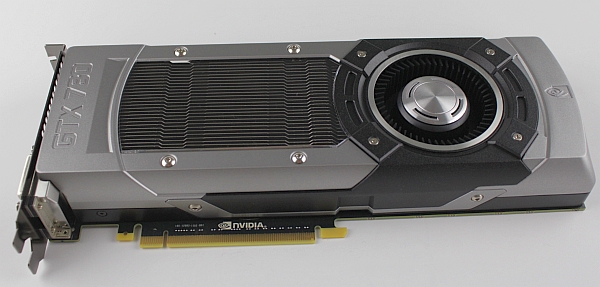
Although the GT110 is based on the Kepler architecture of GTX 680 fame, the GTX 780 ends up significantly faster than Nvidia’s top GPU of 2012.
Like we said in previous reviews, the new GTX 780 is basically a watered down Titan. The GTX 780 has 12 active streaming multi-processors (SMX) out of a total of 15 SMX blocks in the GK110. It has 2304 CUDA cores and even the Titan isn’t the full GK110, as it has 14 active SMX blocks or 2688 CUDA cores. The GK104 chip used in the GTX 680 has “just” 1536 CUDA cores.
There’s more memory bandwidth, too. The GTX 780 has a 384-bus and the frame buffer was upped from 2048MB to 3072MB. Nvidia also made it possible for partners to come up with custom cards with 6GB of GDDR5 memory. Most users don’t even have that much RAM in their systems, but high-end graphics cards aren’t intended for the average consumer, they go after connoisseurs who don’t mind spending a bit more for a proper gaming experience.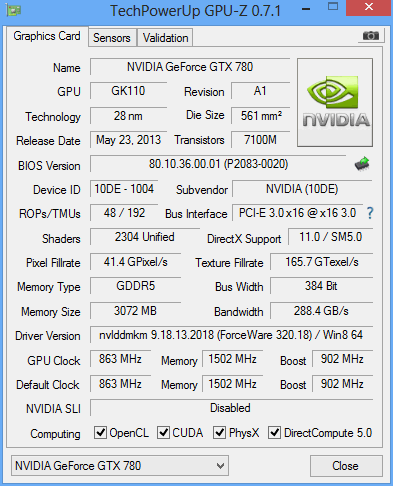
The GTX 780 can draw as much as 250W of power, whereas the GTX 680 is happy with just 195W. The card requires both an 8-pin and a 6-pin PCIe power connector for proper operation. NVIDIA suggests a 600W or greater power supply for the GTX 780, although the recommendation sounds rather pointless - we doubt anyone getting a GTX 780 will have a weaker PSU in their rig.
In the box you’ll find:
User Guide
Quick Installation Guide
Driver DVD
A small note about PCIE 3 compatibility
HDMI to DVI Dongle
DVI to VGA Dongle
1x 6-pin to 8-pin Power Adapter


In order to keep the temperatures at bay, Gainward decided to use the reference cooler, which’s isn’t a bad thing. We already had a chance to get acquainted with Nvidia's reference GTX 780 cooler and we found it more than adequate. We saw it on Gainward’s GTX Titan where it served the card very well indeed. The cooler was designed to provide superior cooling performance and generate acceptable noise.
The cooler sports a silver aluminum casing for the cover and a polycarbonate window for show-offs. Through the window you see the heatsink. The secret to good cooling is a good vapor chamber design, which also allows engineers to come up with compact yet powerful heatsinks that don’t have tons of heaptipes sticking out of them.
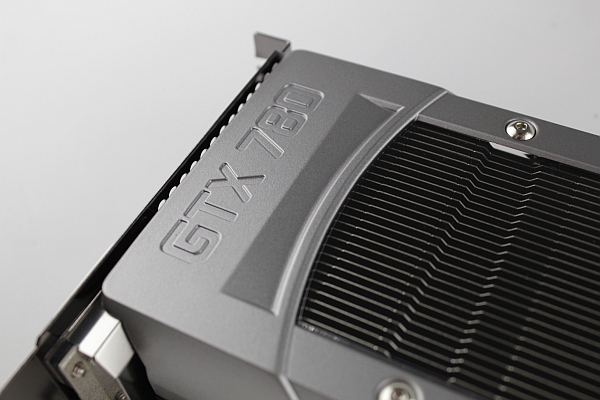
The card is 26.5cm long and it’s 11cm tall. It is a dual-slot affair, which is nothing surprising as it is a reference design. On the upper side we see the GeForce GTX logo with LED backlighting, which was also used on the GTX 690 and Titan.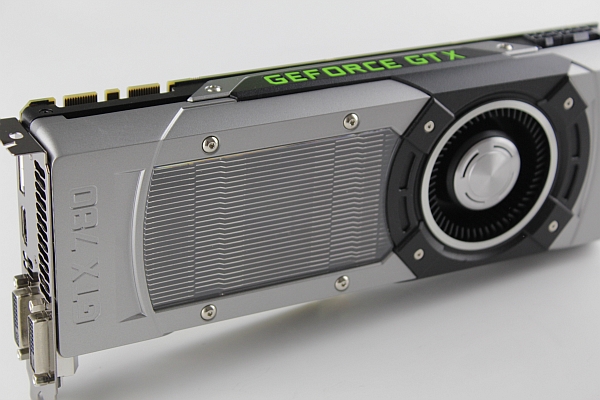
The fan management has been improved, so the 75mm seems rather docile and won’t surprise you with sudden rpm changes. Nvidia’s Boost technology has matured and version 2.0 takes care of things admirably. The GPU temperature threshold is set at 80 degrees Celsius and the card overclocks automatically until the temperature reaches the threshold, provided the load and power consumption readings are not already maxed out.
During auto-overclocking the temperature could be kept within the 80C envelope by accelerating the fan, but Nvidia wanted to keep things quiet, so Boost 2.0 tends to reduce the GPU Boost clock instead of speeding up the fan. Users who place an emphasis on low noise should like this approach, but performance freaks might want a bit more, regardless of noise.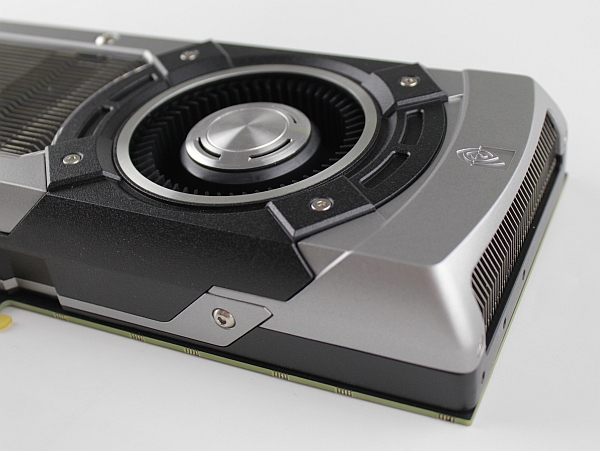
There are no memory modules at the back of the PCB since the GTX 780 has 3GB of memory rather than 6GB used on the Titan. 
The reference design includes Samsung K4G20325FD-FC03 GDDR5 memory chips for the GeForce GTX 780, and Gainward’s card uses them as well. They are specified to run at 1500 MHz (6000 MHz GDDR5 effective).
As far as video outs go, few users will have a gripe, since the card features two dual-link DVIs, 1.4a compatible HDMI and a DisplayPort output. Note that all four video outs can be used simultaneously. Nvidia included an HDMI sound device within the GPU, so there is no need for connecting the card to your SPDIF out to get audio and video via HDMI.
The GTX 780 is ready for multi-GPU action. In addition to standard dual-SLI, it can also be used in triple- and quad-SLI setops, as it features two SLI connectors. The fact that this is a reference dual-slot design also helps.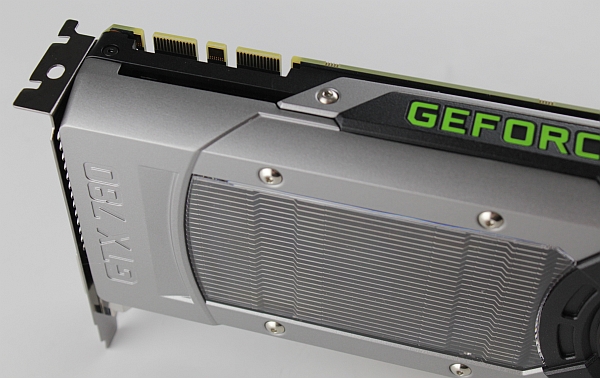
A combination of 6-pin and 8-pin power connectors is used on the GTX 780. The GTX 780 and Titan have a TDP of 250W, although we expect the GTX 780 to be a bit more efficient. The Gainward card uses an OnSemi NCP4206 voltage controller as on the Titan. 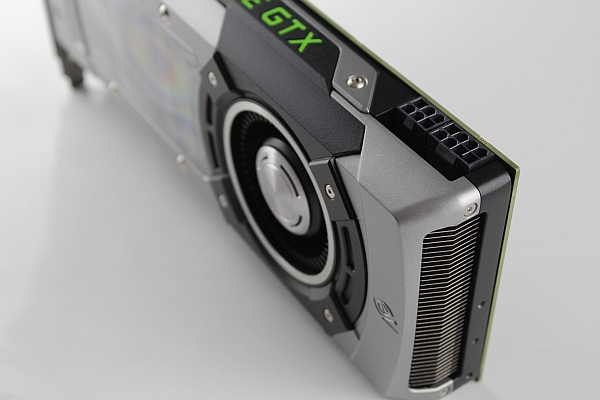
Testbed:
- Motherboard: EVGA Z77 FTW
- CPU: Ivy Bridge Core i7 3770 (4.5GHz)
- CPU Cooler: Gelid The Black Edition
- Memory: 8GB Corsair DDR3 2400MHz
- Harddisk: Corsair Neutron GTX 240GB
- Power Supply: CoolerMaster Silent Pro 1000W
- Case: CoolerMaster Cosmos II Ultra Tower
- Operating System: Win8 64-bit
Drivers:
- Nvidia 320.18-whql
- AMD 13.5_Beta2
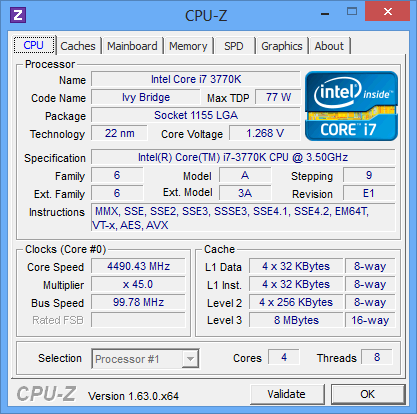
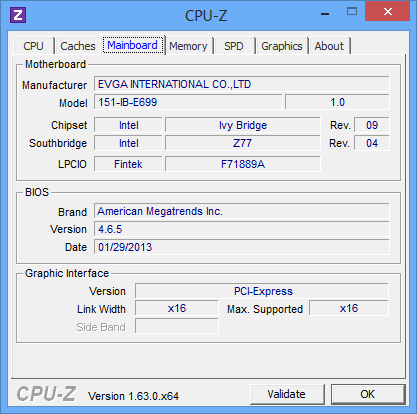
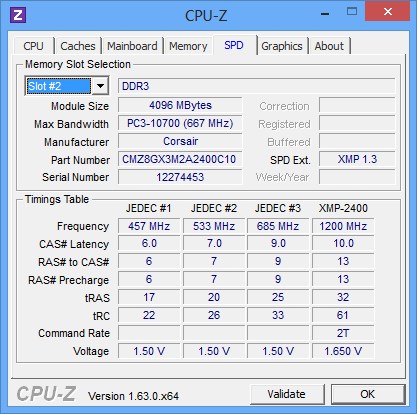

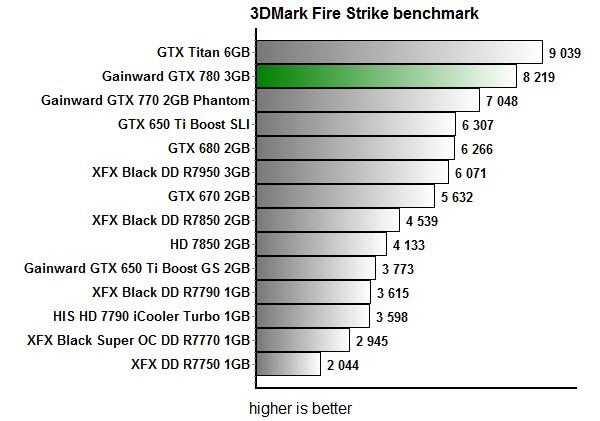
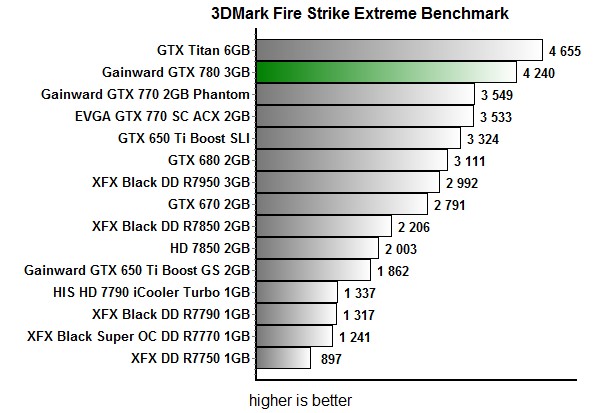

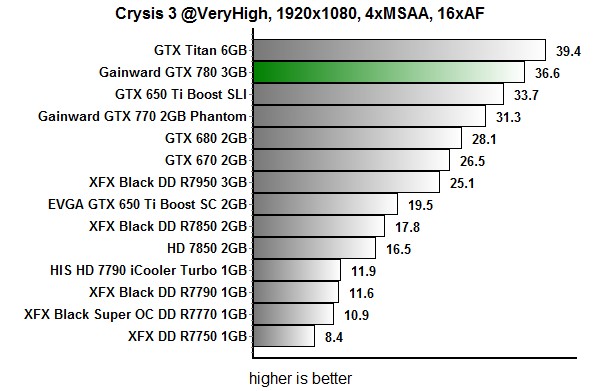

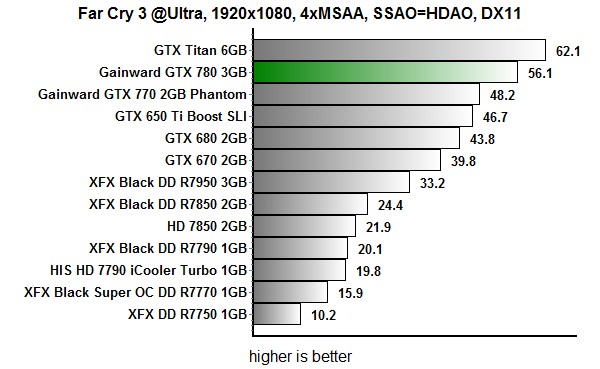

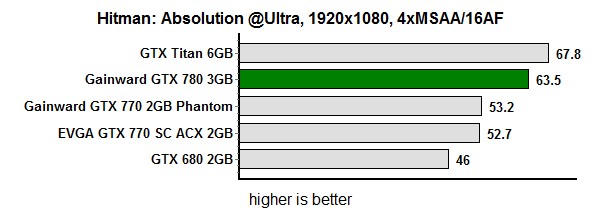
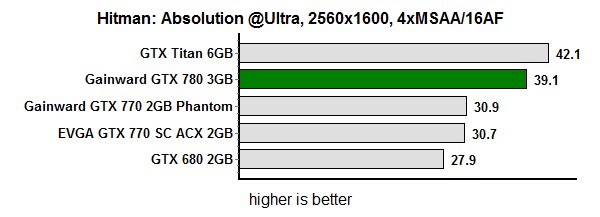


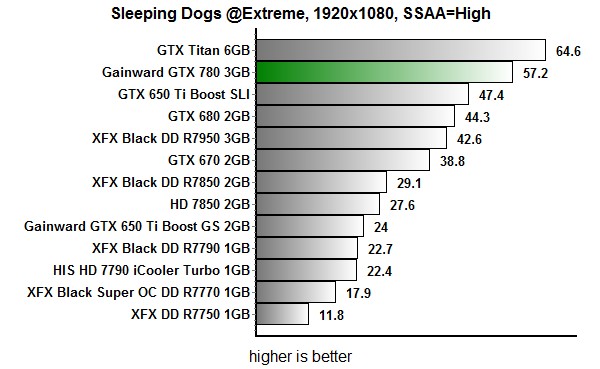





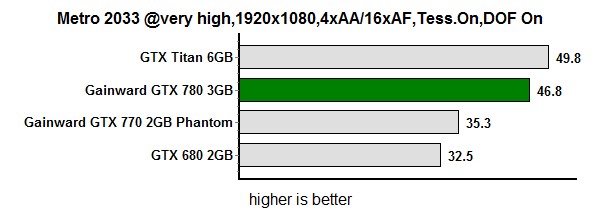

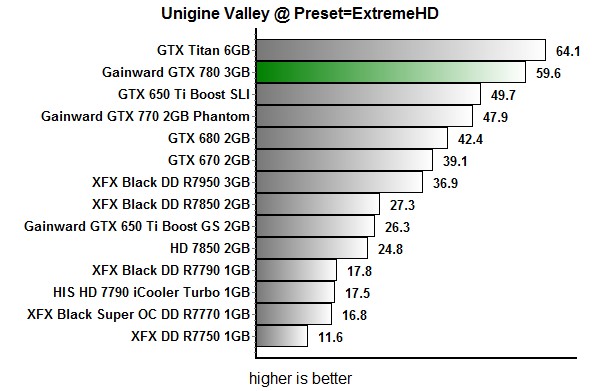


The reference GTX 770 and GTX 780 use the much lauded Titan cooler, which does a very good job at keeping temperatures below the 81 Celsius mark, while remaining reasonably quiet during gaming. The fan speed went fluctuated from 1140RPM at idle to 2130RPM when gaming.
It is the ideal solution for reference clocked cards and it is pretty hard to improve upon. Notice that the Gainward GTX 780 is hitting 979MHz on the core clock when gaming.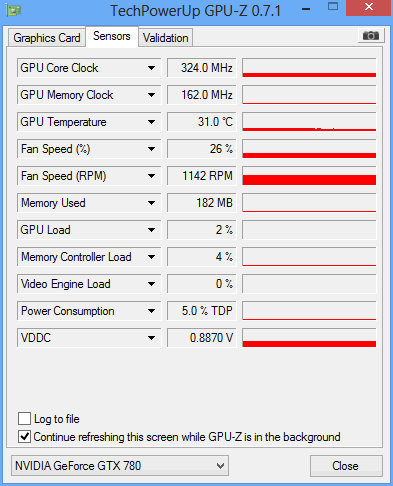
Idle GPU temperature
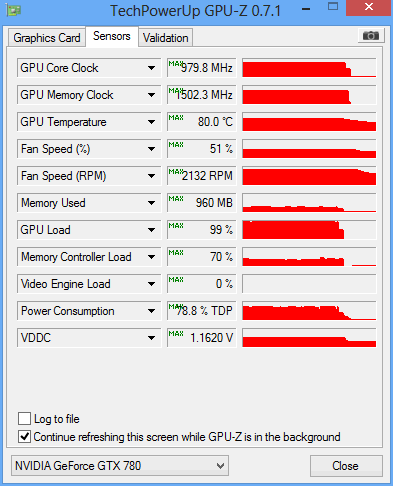
Load GPU temperature
Like on the reference GTX 780, the default temperature limit on the Gainward’s card is set at 80 degrees Celsius. The cooler does a pretty good job and the temperature never exceeds that threshold. After playing Crysis 3 for about 30 minutes we hit 80C and didn't manage to go over that threshold. This basically means that the card will reduce the Boost clock once it hits the threshold, staying within the thermal envelope without revving up the fan.
In terms of performance-per watt efficiency, the Gainward GTX 780 ends up on a par with the GTX 680. Maxing out at below 250W is not all that bad if we consider the high level of performance offered by the card. The GTX Titan has twice the memory and more CUDA cores, so the GTX 780 uses less power under load.
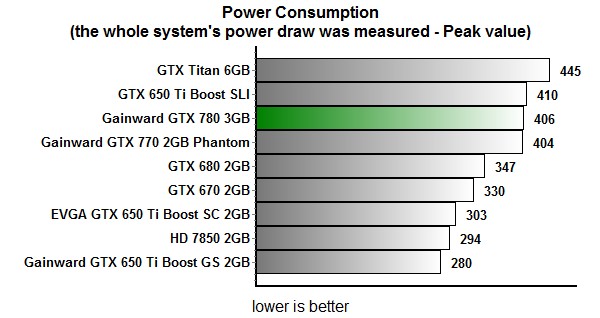
Like we said, Gainward is already working on an overclocked non-reference GTX 780 card, with a new cooler and we can only say that we feel sorry for the engineers. The reference design is very good indeed and it won’t be easy to make it much better without breaking the bank.
In fact, the GTX 780 got so much praise from so many reviewers that one has to wonder what subsequent generations will be like, and what AIBs will have to do to make their non-reference cards appealing.
The GTX 780 is closely related to the Titan, since both cards are based on the new GK110 chip, hence the “new” GTX 700 generation doesn’t really bring a lot of new stuff to the tablet. However, Nvidia seems to have managed to squeeze as much potential from the Kepler architecture as possible, so the new card is an good upgrade over the GTX 680, despite the fact that they are both based on 28nm Kepler chips.
If you do your gaming at 1920x1080 or 2560x1600, you can expect a 20 percent performance boost over the GTX 680, on average of course. What’s more, performance per watt is no worse – in fact in some situations it is even better. Looking at the Titan, it doesn’t seem like a very sensible option if you’re not gunning for higher resolutions or multi-monitor setups. The GTX 780 is much cheaper and it is fast enough.
The cooler is really impressive and we can’t underscore this enough. It is almost silent and even under heavy load it has acceptable level of noise. The fact that quite a few partners didn’t roll out their custom versions of the GTX 780 is a testament to its quality. Therefore Gainward’s decision to launch only a reference card in its first batch is understandable.
The biggest downside is the price. The GTX 780 launched at €650, but we are happy to report that things have changed for the better. Just a month after launch the Gainward GTX 780 dropped to €561, which is much better – but it is still a lot given the disastrous economic situation and record youth unemployment in Europe. However, if you can afford it, we can recommend it.


